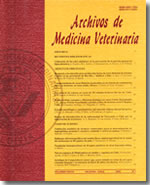Histopatholocial lesions in the small intestine of calostrum deprived pigs invoculated with strains of E. Coli bearing F4, F5, F6 y F41 fimbriaes
Main Article Content
Abstract
A study to evaluate the degrees of lesions caused by different enteropathogenic strains of E. coli was carried out. Newborn piglets without calostrum were innoculated with enteropathogenic strains of E. coli which contained F4, F5, F6 and F41 fimbriae in order to characterize the macro and microscopic lesions to the duodenum, jejunum and ilium.
The pigs experimentally innoculated with the four enteropathegenic strains of E. coli presented watery, yellowish diarrhea four hours p.i. The macroscopic lesions were characterized by congestion and abundant liquid content; only the intensity of the lesions among the different innoculated groups was different. Microscopically, the íleon was the most affected segment, presenting congestion, bacteria adhesion, epitelial vacuolization of the intestinal villus, athrophy, neutrophilic infiltration and linfoid necrosis in the Payer plaques, being E. coli F4 that caused the most severe lesions.
These results confirm the importance of antigens fimbrial as adhesion factors on enteropathogenic E. coli in the small intestine of pigs and the actions of another pathogenic factors. Thus, it opens projections for future methologies which, using the antigenic properties of the fimbriae in the elaboration of immunogenes will contribute to control colibacillosis, avoiding the adhesion of enteropathogenic E. coli.

